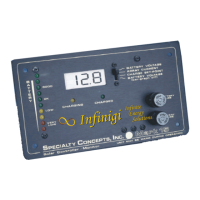INSTALLATION INSTRUCTIONS (continued)
16. OPERATION: - Operation of the charge controller is now fully automatic. If the
battery voltage is below the Full Charge Termination set-point (14.4 volts) and power
is available from the array, the MARK/(15,20) should start up “CHARGING”.
17. CHECK FOR VOLTAGE DROP (OPTIONAL): - Once the system is installed and
operational, a check on the connections is recommended. A poor connection will result
in a voltage loss that will distort the battery voltage reading and cause the charging to
stop too soon. To check the connections, an accurate volt-meter is required, The
MARK/(15,20) must be charging with maximum expected charge current (very sunny
conditions).
Battery Connection: - First, note the voltage at the battery. Then, immediately note
the voltage at the MARK/(15,20) battery terminals. Ideally, the difference in voltage
should be no more than ¼ volt.
Array Connection: - Next, note the voltage at the panel. Then, immediately note the
voltage at the MARK/(15,20) Array terminals. Ideally, the difference should be no
more than ½ volt.
If the voltage drop is more, suspect crimp connections that have not been soldered, in-
line fuses or fuse holders, or loose terminals. If no location of voltage drop is found,
consider using larger wires (or double up the wires) for your run.
Example: You record these readings:
Battery terminals: 13.65 volts
MARK/(15,20) battery connection: 13.95 volts → “.30 volt difference too large.
Decrease voltage drop”
MARK/(15,20) panel connection: 14.10 volts
Panel(s): 14.30 volts → “Connection OK”
8

